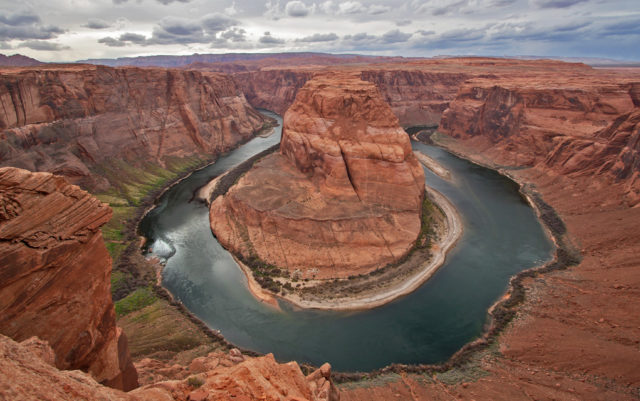
Some Colorado River tribulations today remind me of a folk story: A young man went to visit his fiancée and found the family trembling and weeping. They pointed to the ceiling where an axe was embedded in a rafter.
“That could fall,” the father quavered. “It could kill someone!”
Puzzled, the young man climbed onto a chair, and pulled the axe out of the rafter. Everyone fell all over themselves thanking him. But he quickly broke off the engagement, concerned that such inanity might be inheritable.
This resembles ongoing ditherings over the 1922 Colorado River Compact, a 99-year-old agreement among the seven states through which the Colorado River meanders, on how the consumptive use of the river’s water should be divided to give each state a fair share. The agreement was necessary to get federal participation (money) to build dams to control the erratic river.
The best they were able to do, given the sketchy information they had about each state’s future development and also about the flow of the river, was to divide the river into two “basins” around the natural divide of the Colorado River canyons: Colorado, Utah, Wyoming and New Mexico in the Upper Basin; and California, Arizona and Nevada in the Lower Basin. Each basin would get to consume 7.5 million acre-feet of the river’s water.
This placed a responsibility on the Upper Basin states to “not cause the flow of the river at Lees Ferry (the measuring point in the canyons) to be depleted” below the Lower Basin’s share.
A generous reading of that lawyerly clause in the Compact would say the upper states should just be careful that their water development doesn’t dip into the lower states’ allocation.
A less generous reading would say that if for any reason the flow at Lees Ferry fell below the average of 7.5 million acre-feet — whether it were due to over-appropriation by the upper states or to a natural cause like a 20-year headwaters drought — the lower states would place a call on the upper states, which would have to cut back their own uses and send their water downriver, whether they “caused” the shortage or not.
To maintain that flow in a drought, the upper states would bear the full pain of the drought for the whole river.
Guess which interpretation the upper states chose for their own 1948 compact? Never mind that a Compact call from California (for its share of water) is nowhere mentioned in the 1922 Compact. The axe was planted in the rafter.
They might better have asked how the 1922 Compact creators themselves envisioned the unknown future. The transcripts of the 27 Compact meetings show that the seven state commissioners and their federal chairman Herbert Hoover were concerned, as late as their 21st meeting, that they did not really know enough then about the river’s flows to make a permanent equitable division of the waters.
Hoover summarized their concern, and their intent: “We make now, for lack of a better word, a temporary equitable division,” leaving the further apportionment of the river’s use “to the hands of those men who may come after us, possessed of a far greater fund of information.” They even included in the Compact (Article VI) instructions for reconvening to consider “claims or controversy… over the meaning or performance of any of the terms of this compact.”
By the drought years of the 1930s, it was already obvious that the 7.5 million acre-feet Compact allocations were unrealistic. That would have been a logical time for the upper states to pull the axe out of the rafter, before the river was so fully developed.
But they didn’t, and as the Compact began to take on the aura of something carved in stone on a holy mountain, the fear of the “Compact call” gradually descended into expensive paranoia.
The vastly expensive 24 million acre-feet of storage in Powell Reservoir just upstream from Lees Ferry was created to fulfill the upper Basin’s self-assumed “delivery obligation,” come hell or low water.
But now, hellish low water has come to Powell, and upper states are developing expensive “demand management” programs whereby someone yet unspecified would pay ranchers to fallow fields so their water can be “banked” in Powell against the dreaded “Compact call.”
The seven states are now — finally — initiating negotiations on a more reality-based governance of the Colorado River. Let’s hope they have the good sense to pull that axe out of the rafters before negotiating fair water use under it.
George Sibley is a contributor to Writers on the Range, writersontherange.org, a nonprofit dedicated to spurring lively discussion about Western issues. He has written extensively about the Colorado River.
This opinion column does not necessarily reflect the views of Boulder Weekly.














